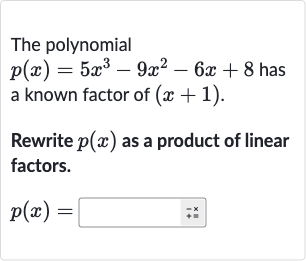AI tutor
Welcome to Bytelearn!
Let’s check out your problem:

The polynomial has a known factor of .Rewrite as a product of linear factors.
Full solution
Q. The polynomial has a known factor of .Rewrite as a product of linear factors.
- Factor Finding: Since we know that is a factor of , we can use polynomial long division or synthetic division to divide by to find the other factors.
- Synthetic Division: Let's perform synthetic division using the root of the known factor, which is .We set up the synthetic division as follows: We bring down the , multiply it by to get , and add it to to get . We then multiply by to get , and add it to to get . Finally, we multiply by to get , and add it to to get , which confirms that is a factor since the remainder is .
- Quotient Polynomial: The result of the synthetic division gives us the coefficients of the quotient polynomial, which is .So, can be written as .
- Factoring Quadratic Polynomial: Now we need to factor the quadratic polynomial . We can try to factor it by looking for two numbers that multiply to and add up to .
- Grouping and Factoring: The two numbers that satisfy these conditions are and , since and .So we can write the quadratic as .
- Common Factor Extraction: Now we can factor by grouping. We group the terms as follows: .
- Complete Factoring: We factor out the common factors from each group: .
- Final Result: Since both terms have a common factor of , we can factor it out to get .
- Final Result: Since both terms have a common factor of , we can factor it out to get .Now we have factored completely into linear factors: .
More problems from Find the inverse of a linear function
QuestionGet tutor help
QuestionGet tutor help
QuestionGet tutor help
QuestionGet tutor help
QuestionGet tutor help
